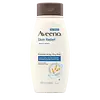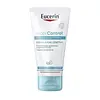What's inside
What's inside
 Key Ingredients
Key Ingredients

 Benefits
Benefits

 Concerns
Concerns

 Ingredients Side-by-side
Ingredients Side-by-side

Water
Skin ConditioningGlycerin
HumectantCocamidopropyl Betaine
CleansingPEG-80 Sorbitan Laurate
Sodium Cocoyl Isethionate
CleansingAvena Sativa Kernel Flour
AbrasiveAvena Sativa Kernel Extract
AbrasiveAvena Sativa Kernel Oil
Skin ConditioningAcrylates/C10-30 Alkyl Acrylate Crosspolymer
Emulsion StabilisingDipropylene Glycol
HumectantEthylene Brassylate
Masking2,6-Dimethyl-7-Octen-2-Ol
MaskingPelargonium Graveolens Flower Oil
MaskingCommiphora Myrrha Oil
MaskingCaprylyl Glycol
EmollientSodium Benzoate
MaskingPotassium Sorbate
PreservativeSodium Hydroxide
BufferingWater, Glycerin, Cocamidopropyl Betaine, PEG-80 Sorbitan Laurate, Sodium Cocoyl Isethionate, Avena Sativa Kernel Flour, Avena Sativa Kernel Extract, Avena Sativa Kernel Oil, Acrylates/C10-30 Alkyl Acrylate Crosspolymer, Dipropylene Glycol, Ethylene Brassylate, 2,6-Dimethyl-7-Octen-2-Ol, Pelargonium Graveolens Flower Oil, Commiphora Myrrha Oil, Caprylyl Glycol, Sodium Benzoate, Potassium Sorbate, Sodium Hydroxide
Water
Skin ConditioningGlycerin
HumectantOctyldodecanol
EmollientCetyl Alcohol
EmollientGlyceryl Stearate
EmollientCaprylic/Capric Triglyceride
MaskingMethylpropanediol
SolventStearyl Alcohol
EmollientHydrogenated Coco-Glycerides
EmollientButyrospermum Parkii Butter
Skin ConditioningGlyceryl Stearate Se
EmulsifyingCetyl Palmitate
EmollientColloidal Oatmeal
AbsorbentGlycyrrhiza Inflata Root Extract
Skin ConditioningCeramide NP
Skin ConditioningPhytosphingosine
Skin ConditioningMenthoxypropanediol
MaskingGlycine
BufferingSodium PCA
HumectantDecylene Glycol
Skin ConditioningCitric Acid
BufferingSodium Citrate
BufferingSodium Cetearyl Sulfate
CleansingCaprylyl Glycol
EmollientOleic Acid
EmollientEthylhexylglycerin
Skin ConditioningPhenoxyethanol
PreservativeBenzyl Alcohol
PerfumingWater, Glycerin, Octyldodecanol, Cetyl Alcohol, Glyceryl Stearate, Caprylic/Capric Triglyceride, Methylpropanediol, Stearyl Alcohol, Hydrogenated Coco-Glycerides, Butyrospermum Parkii Butter, Glyceryl Stearate Se, Cetyl Palmitate, Colloidal Oatmeal, Glycyrrhiza Inflata Root Extract, Ceramide NP, Phytosphingosine, Menthoxypropanediol, Glycine, Sodium PCA, Decylene Glycol, Citric Acid, Sodium Citrate, Sodium Cetearyl Sulfate, Caprylyl Glycol, Oleic Acid, Ethylhexylglycerin, Phenoxyethanol, Benzyl Alcohol
 Reviews
Reviews

Ingredients Explained
These ingredients are found in both products.
Ingredients higher up in an ingredient list are typically present in a larger amount.
Caprylyl Glycol is a humectant and emollient, meaning it attracts and preserves moisture.
It is a common ingredient in many products, especially those designed to hydrate skin. The primary benefits are retaining moisture, skin softening, and promoting a healthy skin barrier.
Though Caprylyl Glycol is an alcohol derived from fatty acids, it is not the kind that can dry out skin.
This ingredient is also used as a preservative to extend the life of products. It has slight antimicrobial properties.
Learn more about Caprylyl GlycolGlycerin is already naturally found in your skin. It helps moisturize and protect your skin.
A study from 2016 found glycerin to be more effective as a humectant than AHAs and hyaluronic acid.
As a humectant, it helps the skin stay hydrated by pulling moisture to your skin. The low molecular weight of glycerin allows it to pull moisture into the deeper layers of your skin.
Hydrated skin improves your skin barrier; Your skin barrier helps protect against irritants and bacteria.
Glycerin has also been found to have antimicrobial and antiviral properties. Due to these properties, glycerin is often used in wound and burn treatments.
In cosmetics, glycerin is usually derived from plants such as soybean or palm. However, it can also be sourced from animals, such as tallow or animal fat.
This ingredient is organic, colorless, odorless, and non-toxic.
Glycerin is the name for this ingredient in American English. British English uses Glycerol/Glycerine.
Learn more about GlycerinWater. It's the most common cosmetic ingredient of all. You'll usually see it at the top of ingredient lists, meaning that it makes up the largest part of the product.
So why is it so popular? Water most often acts as a solvent - this means that it helps dissolve other ingredients into the formulation.
You'll also recognize water as that liquid we all need to stay alive. If you see this, drink a glass of water. Stay hydrated!
Learn more about Water